Related Research Articles
Located about 2300 miles (3680 km) from the nearest continental shore, the Hawaiian Islands are the most isolated group of islands on the planet. The plant and animal life of the Hawaiian archipelago is the result of early, very infrequent colonizations of arriving species and the slow evolution of those species—in isolation from the rest of the world's flora and fauna—over a period of at least 5 million years. As a consequence, Hawai'i is home to a large number of endemic species. The radiation of species described by Charles Darwin in the Galapagos Islands which was critical to the formulation of his theory of evolution is far exceeded in the more isolated Hawaiian Islands.

The Kauaʻi ʻōʻō or ʻōʻōʻāʻā was the last member of the ʻōʻō (Moho) genus within the Mohoidae family of birds from the islands of Hawaiʻi. The entire family is now extinct. It was previously regarded as a member of the Australo-Pacific honeyeaters.
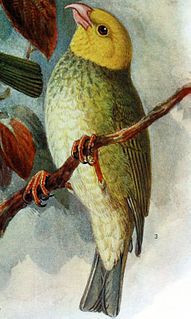
The ʻōʻū is a species of Hawaiian honeycreeper endemic to the Hawaiian islands. It has a dark green back and olive green underparts; males have a yellow head while females have a green head. Its unusual beak seems to be adapted to feeding on the fruits of Freycinetia arborea. It has a strong flight which it uses to fly considerable distances in search of this Hawaiian endemic vine, but will eat other fruits, buds, flowers and insects.

The Alakaʻi Wilderness Preserve, popularly known as Alakaʻi Swamp, is a montane wet forest on the Hawaiian island of Kauaʻi. Although the preserve is home to alpine bogs, it is not a true swamp. It is located on a plateau near Mount Waiʻaleʻale, one of the wettest spots on Earth. Due to its unique combination of high elevation and climate, the Alakaʻi Swamp harbors a large number of endangered endemic species that are only found in this area and whose population has been dramatically declining over the last decades. It is designated as a IUCN protected area.
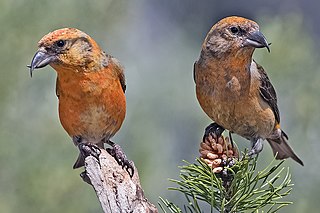
The cardueline finches are a subfamily, Carduelinae, one of three subfamilies of the finch family Fringillidae, the others being the Fringillinae and the Euphoniinae. The Hawaiian honeycreepers are now included in this subfamily. Except for the Hawaiian honeycreepers which underwent adaptive radiation in Hawaii and have evolved a broad range of diets, cardueline finches are specialised seed eaters, and unlike most passerine birds, they feed their young mostly on seeds, which are regurgitated. Besides this, they differ from the other finches in some minor details of their skull. They are adept at opening seeds and clinging to stems, unlike other granivorous birds, such as sparrows and buntings, which feed mostly on fallen seeds. Some members of this subfamily are further specialised to feed on a particular type of seed, such as cones in the case of crossbills. Carduelines forage in flocks throughout the year, rather than keeping territories, and males defend their females rather than a territory or nest.

Ciridops is an extinct genus of Hawaiian honeycreeper species that occurred in prehistoric and historic times on the Hawaiian islands of Hawaii, Molokai, Kauai and Oahu. This genus was created in 1892 by Alfred Newton in an article published by the journal Nature on the basis of the ʻula-ʻai-hawane, which was named Fringilla anna by Sanford B. Dole in 1879.
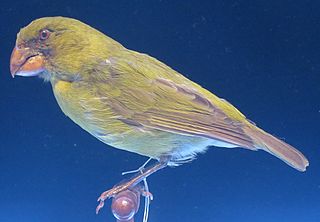
The Kona grosbeak is an extinct species of Hawaiian honeycreeper. The Kona grosbeak was endemic to naio forests on ʻaʻā lava flows at elevations of 1,400–1,500 metres (4,600–4,900 ft) near the Kona District on the island of Hawaii. The species was already very rare when it was first discovered, being found in only about 10 square kilometres (3.9 sq mi), and was last collected in 1894. Reasons for its extinction are not very well known. The genus is known from fossils from Kauai, Oahu and Maui. It was unknown to the Native Hawaiians, and thus a name for it does not exist in the Hawaiian language.

Chloridops is an extinct genus of Hawaiian honeycreeper in the subfamily Carduelinae of the family Fringillidae.

Hemignathus is a Hawaiian honeycreeper genus in the subfamily Carduelinae of the finch family, Fringillidae.

The nukupuʻu is a group of critically endangeredspecies of Hawaiian honeycreeper in the family Fringillidae. There are no recent confirmed records for any of the species and they may be extinct or functionally extinct. Habitat was dense mesic and wet forest of ʻōhiʻa lehua and koa at altitudes of 3,300–6,600 feet (1,000–2,000 m).
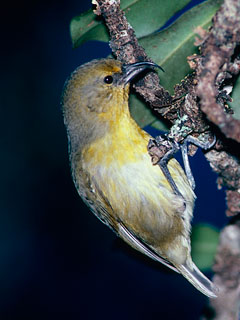
The ʻakiapōlāʻau, pronounced ah-kee-ah-POH-LAH-OW, is a species of Hawaiian honeycreeper that is endemic to the island of Hawaii. Its natural habitats are dry and montane moist forests, and the only bird species on the island to occupy the woodpecker niche. The bird is 5.5 inches (14 cm) in length, and has an unusually curved beak-(a specialist species). The ʻakiapolaʻau is a pudgy bird which has a whitish bottom and tail, black legs, yellow chest, orangish head, black face mask and bill and gray black wings. The male's song is either a loud, short pit-er-ieu or a rapid warba-warba. Its various calls include an upslurred whistle, a short cheedle-ee warble, and a short sweet. Due to the recent disappearance of the Kauai nukupuʻu in the 1900s and the Maui nukupuʻu in the 1990s, leading to fears that they may be extinct, the ʻakiapōlāʻau may be the last of its genus. It is the only member of the subgenus Heterorhynchus, which has a woodpecker-like feeding habitat and exclusively preys on insects, in contrast to the nukupu'us, which were both insect-eaters and also hummingbird-like nectarivores.

The Hawaiʻi ʻamakihi, also known as the common ʻamakihi, is a species of Hawaiian honeycreeper.
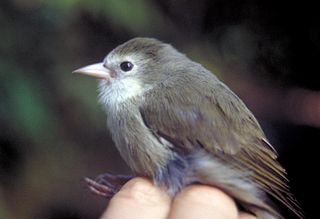
The ʻakikiki, also called the Kauaʻi creeper, is a critically endangered Hawaiian honeycreeper endemic to Kauaʻi, Hawaiʻi.
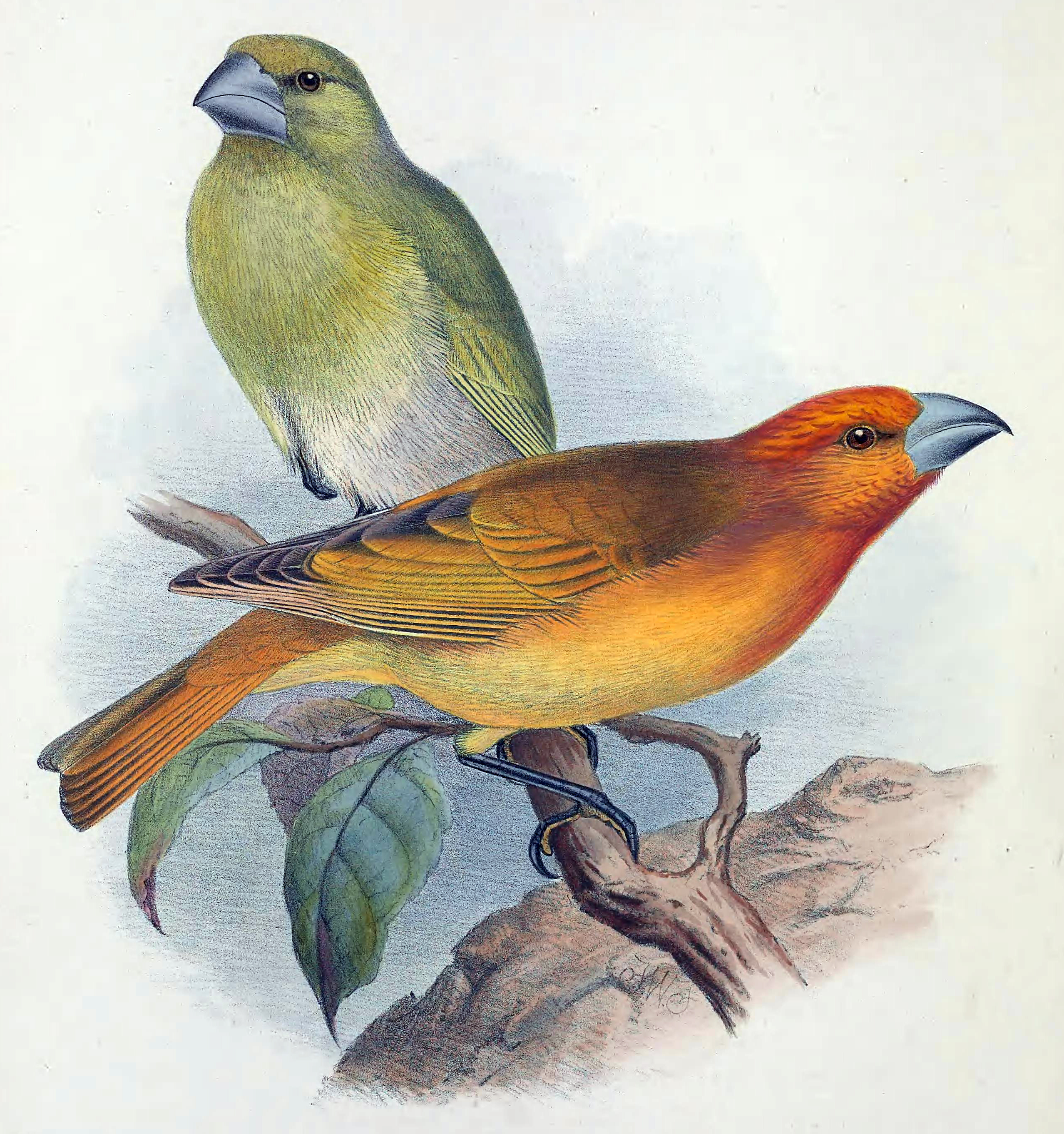
Rhodacanthis is an extinct genus of Hawaiian honeycreepers commonly known as koa finches. All four species were endemic to the Hawaiian Islands. Members of this genus were granivores, with bills adapted to the seeds and pods of legumes. The two species that became extinct in the 1890s, R. flaviceps and R. palmeri, inhabited upper elevation mesic forests dominated by koa (Acacia koa) on the island of Hawaiʻi. Both were large birds; R. flaviceps measured 19 cm (7.5 in), while R. palmeri was 23 cm (9.1 in) in length. The combination of a giant bill with brightly colored plumage gave the males a very striking appearance. Koa seeds were the preferred food for the two species, but caterpillars were taken if necessary. The two prehistoric species, R. forfex and R. litotes, were denizens of more lowland tropical dry forests and shrublands on Kauaʻi, Maui, and Oʻahu. It is speculated that koaiʻa was an important food source for both species, as their range did not overlap with that of koa. Kanaloa pods and ʻaʻaliʻi berries were probably also eaten in addition to the occasional caterpillar.
The wahi grosbeak or Oʻahu grosbeak is a prehistoric species of Hawaiian honeycreeper. The wahi grosbeak was endemic to dry forests on the Hawaiian islands of Kauaʻi, Oʻahu, and Maui. Based on the thickness of its bill it fed on seeds easier to crack than those of the naio, on which the Kona grosbeak fed. The species was already extinct when Europeans landed on the island. Being only known from fossils, its behavior and the exact reasons for its extinction are essentially unknown. Its fossils have been found throughout the islands, but were present in higher concentrations in caves. The bird was smaller than the related King Kong grosbeak by 2 inches (5.1 cm). It had a total length of 9 inches (23 cm).
The hoopoe-billed ʻakialoa,, is an extinct species of Hawaiian honeycreeper. Subfossil remains have been found of this species in the Hawaiian islands of Kauai and Oahu. The species specific name, upupirostris, is derived from the Latin upupa, hoopoe, and rostrum, bill, and refers to the long sickle-shaped bill which resembles that of the hoopoe. The species was apparently slightly larger than others in its genus. A similar but smaller bird has been discovered but is as yet undescribed from the island of Maui. The species presumably became extinct after the arrival of humans in Hawaii, and is known only from the fossil record.

The Oʻahu nukupuʻu was a species of nukupuʻu which was similar to its cousins from the Islands of Kauaʻi and Maui.
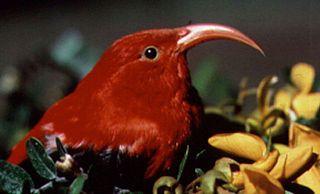
Hawaiian honeycreepers are a group of small, passerine birds endemic to Hawaiʻi. They are closely related to the rosefinches in the genus Carpodacus, but many species have evolved features unlike those present in any other finch. Their great morphological diversity is the result of adaptive radiation in an insular environment. Many have been driven to extinction since the first humans arrived in Hawaii, with extinctions increasing over the last 2 centuries following European discovery of the islands, with habitat destruction and especially invasive species being the main causes.
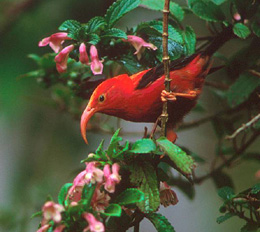
Drepanidini is a tribe of cardueline finches containing the Hawaiian honeycreepers. It was formerly considered one of three Hawaiian honeycreeper tribes, and restricted to the genera Ciridops, Drepanis, Himatione, Melamprosops, and Palmeria, most of which are nectarivores with brightly-colored or boldly-patterned plumage and songs containing nasal squeaks and whistles. However, as these three tribes were each para- or polyphyletic, and as Hawaiian honeycreepers are no longer treated as their own subfamily or family, Drepanidini is now typically used for all Hawaiian honeycreepers.
References
- ↑ Robert D. Craig, Russell T. Clement: Who's Who in Oceania p 155, 1980–1981. Brigham Young University--Hawaii Campus. Institute for Polynesian Studies
- 1 2 Pratt, H. Douglas (2009). "Biography" . Retrieved January 5, 2010.
- ↑ Sheila Conant, H. Douglas Pratt & Robert J. Shallenberger: Reflections on a 1975 expedition to the lost world of the Alakai and other notes on the natural history, systematics, and conservation of Kauai birds In: Wilson Bulletin, 110(l), 1998, p. l-22
- ↑ "Kauai Oo -- Moho braccatus". Archived from the original on February 2, 2017. Retrieved March 2, 2022.
- 1 2 Pratt, H. Douglas; Bruner, Philip L.; Berret, Delwyn G. (1987). A Field Guide to the Birds of Hawaii and the Tropical Pacific. Princeton University Press. pp. 283, 284. ISBN 0-691-02399-9.
- ↑ Pratt, H. Douglas (October 2009). "A New Genus for the Hawai'i Creeper, with Comments on Generic Limits among Insectivorous Hawaiian Honeycreepers" (PDF). 'Elepaio – Journal of the Hawaii Audubon Society. Honolulu: Hawaii Audubon Society. 69 (7): 47–54. Archived from the original (PDF) on July 11, 2011. Retrieved July 13, 2013.
- ↑ Walnut Festival Contests